Observational Analysis of the Characteristics of the Synoptic Situation and Evolution of the Organized Warm-Sector Rainfall in the Coastal Region of South China in the Pre-Summer Rainy Season
Abstract
1. Introduction
2. Data and Methodology
3. Synoptic Situation, Extension, and Orientation of the Coastal OWSRs
4. Motion of the Coastal OWSRs
5. Discussion and Conclusions
Author Contributions
Funding
Conflicts of Interest
References
- Ramage, C. Variation of rainfall over south China through the wet season. Am. Meteorol. Soc. 1952, 33, 308–311. [Google Scholar] [CrossRef]
- Yuan, F.; Wei, K.; Chen, W.; Fong, S.K.; Leong, K.C. Temporal variations of the frontal and monsoon storm rainfall during the first rainy season in South China. Atmos. Ocean. Sci. Lett. 2010, 3, 243–247. [Google Scholar]
- Ding, Y.H.; Chan, J.C.L. The East Asian summer monsoon: An overview. Meteorol. Atmos. Phys. 2005, 89, 117–142. [Google Scholar]
- Li, Z.G.; Liang, B.Q.; Bao, C.L. Mechanism and prediction of pre-rainy season heavy rainfall in South China. In Collected Papers of Pre-Rainy Season Heavy Rainfall in South China; China Meteorological Press: Beijing, China, 1981. (In Chinese) [Google Scholar]
- Liang, Q.Q.; Meng, W.G.; Sun, X.Y.; Zhang, Y.X. Contrastive analysis of frontal rainstorm vs. monsoon rainstorm processes during the April-May-June raining season vs. July-August-September raining season. J. Trop. Meteorol. 2019, 35, 51–62. (In Chinese) [Google Scholar]
- Gu, W.; Wang, L.; Hu, Z.-Z.; Hu, K.; Li, Y. Interannual variations of the first rainy season precipitation over south China. J. Clim. 2018, 31, 623–640. [Google Scholar] [CrossRef]
- Yuan, C.; Liu, J.; Luo, J.J.; Guan, Z. Influences of tropical Indian and Pacific oceans on the interannual variations of precipitation in the early and late rainy seasons in South China. J. Clim. 2019, 32, 3681–3694. [Google Scholar] [CrossRef]
- Huang, L.; Luo, Y.; Zhang, D.L. The relationship between anomalous pre-summer extreme rainfall over south China and synoptic disturbances. J. Geophys. Res. Atmos. 2018, 123, 3395–3413. [Google Scholar] [CrossRef]
- Miao, R.; Wen, M.; Zhang, R.; Li, L. The influence of wave trains in mid-high latitudes on persistent heavy rain during the first rainy season over South China. Clim. Dyn. 2019, 53, 2949–2968. [Google Scholar] [CrossRef]
- Chen, Y.; Luo, Y. Analysis of paths and sources of moisture for the south China rainfall during the pre-summer rainy season of 1979–2014. J. Meteorol. Res. 2018, 32, 744–757. [Google Scholar] [CrossRef]
- Ding, Y.H. Summer monsoon rainfalls in China. J. Meteorol. Soc. Jpn. 1992, 70, 373–396. [Google Scholar] [CrossRef]
- Qian, J.H.; Tao, W.K.; Lau, K.M. Mechanisms for torrential rain associated with the mei-yu development during SCSMEX 1998. Mon. Weather Rev. 2004, 132, 3–27. [Google Scholar] [CrossRef]
- Sampe, T.; Xie, S. Large-scale dynamics of the Meiyu-Baiu Rainband: Environmental forcing by the westerly jet. J. Clim. 2010, 23, 113–134. [Google Scholar] [CrossRef]
- Li, T.; Wang, B.; Wu, B.; Zhou, T.; Chang, C.-P.; Zhang, R. Theories on formation of an anomalous anticyclone in western North Pacific during EL Nino: A review. J. Meteorol. Res. 2017, 31, 987–1006. [Google Scholar] [CrossRef]
- Luo, Y.L.; Gong, Y.; Zhang, D.L. Initiation and organizational modes of an extreme-rain-producing mesoscale convective system along a Mei-Yu front in east China. Mon. Weather Rev. 2014, 142, 203–221. [Google Scholar] [CrossRef]
- Li, H.; Hu, Y.; Zhou, Z.; Peng, J.; Xu, X. Characteristics features of the evolution of a Meiyu frontal rainstorm with Doppler radar data assimilation. Adv. Meteorol. 2018, 2018, 1–17. [Google Scholar] [CrossRef]
- Xue, M.; Luo, X.; Zhu, K.; Sun, Z.; Fei, J. The controlling role of boundary layer inertial oscillations in Meiyu frontal precipitation and its diurnal cycles over China. J. Geophys. Res. Atmos. 2018, 123, 5090–5115. [Google Scholar] [CrossRef]
- Huang, S.S. Rain Storm in South China in Early Summer; Guangdong Science and Technology Press: Guangzhou, China, 1986. (In Chinese) [Google Scholar]
- Zhao, S.X.; Bei, N.F.; Sun, J.H. Mesoscale analysis of a heavy rainfall event over Hong Kong during a pre-rainy season in South China. Adv. Atmos. Sci. 2007, 24, 555–572. [Google Scholar] [CrossRef]
- Luo, Y.; Zhang, R.; Wan, Q.; Wang, B.; Wong, W.K.; Hu, Z.; Jou, B.J.D.; Lin, Y.; Johnson, R.H.; Chang, C.P.; et al. The Southern China Monsoon Rainfall Experiment (SCMREX). Bull. Am. Meteorol. Soc. 2017, 98, 999–1013. [Google Scholar] [CrossRef]
- Chen, G.; Lan, R.; Zeng, W.; Pan, H.; Li, W. Diurnal variations of rainfall in surface and satellite observations at the monsoon coast (South China). J. Clim. 2018, 31, 1703–1724. [Google Scholar] [CrossRef]
- Luo, Y.L. Advances in understanding the early-summer heavy rainfall over South China. In The Global Monsoon System, 3rd ed.; Chang, C.-P., Ding, Y., Lau, N.-C., Johnson, R.H., Wang, B., Yasunari, T., Eds.; World Scientific: Singapore, 2017; pp. 215–226. [Google Scholar]
- Du, Y.; Chen, G.X. Heavy rainfall associated with double low-level jets over southern China. Part I: Ensemble-based analysis. Mon. Weather Rev. 2018, 146, 3827–3844. [Google Scholar] [CrossRef]
- Ding, Y.H. Monsoons Over China; Kluwer Acad.: Norwell, MA, USA, 1994. [Google Scholar]
- Chen, S.J.; Kuo, Y.H.; Wang, W.; Tao, Z.Y.; Cui, B. A modeling case study of heavy rainstorms along the mei-yu front. Mon. Weather Rev. 1998, 126, 2330–2351. [Google Scholar] [CrossRef]
- He, L.F.; Chen, T.; Kong, Q. A review of studies on prefrontal torrential rain in South China. J. Appl. Meteorol. Sci. 2016, 27, 559–569. (In Chinese) [Google Scholar]
- Zhang, X.; Luo, Y.; Wan, Q.; Ding, W.; Sun, J. Impact of assimilating wind profiling radar observations on convection-permitting quantitative precipitation forecasts during SCMREX. Weather Forecast. 2016, 31, 1271–1292. [Google Scholar] [CrossRef]
- Bao, X.; Luo, Y.; Sun, J.; Meng, Z.; Yue, J. Assimilating Doppler radar observations with an ensemble Kalman filter for convection-permitting prediction of convective development in a heavy rainfall event during the pre-summer rainy season of South China. China Earth Sci. 2017, 60, 1866–1885. [Google Scholar] [CrossRef]
- Qian, Q.; Lin, Y.; Luo, Y.; Zhao, X.; Zhao, Z.; Luo, Y.; Liu, X. Sensitivity of a simulated squall line during SCMREX to parameterization of microphysics. J. Geophys. Res. Atmos. 2018, 123, 4197–4220. [Google Scholar] [CrossRef]
- Furtado, K.; Field, P.R.; Luo, Y.; Liu, X.; Guo, Z.; Zhou, T.; Shipway, B.J.; Hill, A.A.; Wilkinson, J.M. Cloud microphysical factors affecting simulations of deep convection during the pre-summer rainy season in Southern China. J. Geophys. Res. Atmos. 2018, 123, 10477–10505. [Google Scholar] [CrossRef]
- Furtado, K.; Field, P.; Luo, Y.; Zhou, T.; Hill, A. The effects of cloud-aerosol-interaction complexity on simulations of pre-summer rainfall over southern China. Chem. Phys. Discuss. 2019. in review. [Google Scholar] [CrossRef]
- Huang, L.; Luo, Y. Evaluation of quantitative precipitation forecasts by TIGGE ensembles for south China during the pre-summer rainy season. J. Geophys. Res. Atmos. 2017, 122, 8494–8516. [Google Scholar] [CrossRef]
- Zhang, X. Application of a convection-permitting ensemble prediction system to quantitative precipitation forecasts over southern China: Preliminary results during SCMREX. Q. J. R. Meteorol. Soc. 2018, 144, 2842–2862. [Google Scholar] [CrossRef]
- Zhang, X. Multi-scale characteristics of different source perturbations and their interactions for convection-permitting ensemble forecasting during SCMREX. Mon. Weather Rev. 2019, 147, 291–310. [Google Scholar] [CrossRef]
- Zhou, X.J.; Xue, J.S.; Tao, Z.Y.; Zhao, S.X.; Yi, Q.J.; Su, B.X. Scientific Test Study of Rainstorm in Huanan in 1998; China Meteorological Press: Beijing, China, 2003. (In Chinese) [Google Scholar]
- Zhang, R.; Ni, Y.; Liu, L.; Luo, Y.; Wang, Y. South China Heavy Rainfall Experiments (SCHeREX). Meteorol. Soc. Jpn. 2011, 89A, 153–166. [Google Scholar] [CrossRef]
- Ni, Y.Q.; Zhang, R.H.; Liu, L.P. Rainstorms in South China Field Science Experiment (SCHeREX); China Meteorological Press: Beijing, China, 2013. (In Chinese) [Google Scholar]
- Chen, X.; Zhang, F.; Zhao, K. Diurnal variations of the land–sea breeze and its related precipitation over South China. J. Atmos. Sci. 2016, 73, 4793–4815. [Google Scholar] [CrossRef]
- Wang, H.; Luo, Y.; Jou, B.J.D. Initiation, maintenance, and properties of convection in an extreme rainfall event during SCMREX: Observational analysis. J. Geophys. Res. Atmos. 2014, 119, 206–232. [Google Scholar] [CrossRef]
- Huang, Y.; Liu, Y.; Liu, Y.; Li, H.; Knievel, J.C. Mechanisms for a record-breaking rainfall in the coastal metropolitan city of Guangzhou, China: Observation analysis and nested very large eddy simulation with the WRF model. J. Geophys. Res. Atmos. 2019, 124, 1370–1391. [Google Scholar] [CrossRef]
- Wu, M.; Luo, Y.; Chen, F.; Wong, W.-K. Observed link of extreme hourly precipitation changes to urbanization over coastal South China. J. Appl. Meteorol. Clim. 2019, 58, 1799–1819. [Google Scholar] [CrossRef]
- Lin, L.X. Guangdong Province Weather Forecasting Technology Manual; China Meteorological Press: Beijing, China, 2006. (In Chinese) [Google Scholar]
- Du, Y.; Rotunno, R. Diurnal cycle of rainfall and winds near the south coast of china. J. Atmos. Sci. 2018, 75, 2065–2082. [Google Scholar] [CrossRef]
- Du, Y.; Chen, G. Heavy rainfall associated with double low-level jets over southern china. Part II: Convection initiation. Mon. Weather Rev. 2019, 147, 543–565. [Google Scholar] [CrossRef]
- Liu, X.; Luo, Y.; Guan, Z.; Zhang, D.-L. An extreme rainfall event in coastal South China during SCMREX-2014: Formation and roles of Rainband and Echo trainings. J. Geophy. Res. Atmos. 2018, 123, 9256–9278. [Google Scholar] [CrossRef]
- Cathryn, E.B.; Malcolm, J.R.; Luis, G.C.; Duncan, A.; Micheal, J.R.; Adrian, P.L.; Reinhard, S. Sea-Breeze Dynamics and Convection Initiation: The Influence of Convective Parameterization in Weather and Climate Model Biases. J. Clim. 2015, 28, 8093–8108. [Google Scholar]
- Chen, X.; Zhao, K.; Xue, M. Influence of monsoonal wind speed and moisture content on intensity and diurnal variations of the mei-yu season coastal rainfall over south China. J. Atmos. Sci. 2017, 74, 2835–2856. [Google Scholar] [CrossRef]
- Xu, Y.; Yan, J.H.; Wang, Q.Q.; Dong, J.B. A low-level gravity wave triggering mechanism for rainstorm of warm zone in South China. Plateau Meteorol. 2013, 32, 1050–1061. (In Chinese) [Google Scholar]
- Zhong, S.; Chen, Z. The impacts of atmospheric moisture transportation on warm sector torrential rains over South China. Atmosphere 2017, 8, 116. [Google Scholar] [CrossRef]
- Chen, X.C.; Zhao, K.; Xue, M. Spatial and temporal characteristics of warm season convection over Pearl River Delta region, China, based on 3 years of operational radar data. J. Geophys. Res. Atmos. 2014, 119, 447–465. [Google Scholar] [CrossRef]
- Wu, M.W.; Luo, Y.L. Mesoscale observational analysis of lifting mechanism of a warm-sector convective system producing the maximal daily precipitation in China mainland during pre-summer rainy season of 2015. J. Meteorol. Res. Atmos. 2016, 30, 719–736. [Google Scholar] [CrossRef]
- Darby, L.S.; Banta, R.M.; Pielke, R.A., Sr. Comparisons between mesoscale model terrain sensitivity studies and Doppler lidar measurements of the sea breeze at Monterey Bay. Mon. Weather Rev. 2002, 130, 2813–2838. [Google Scholar] [CrossRef]
- Barthlott, C.; Kirshbaum, D.J. Sensitivity of deep convection to terrain forcing over Mediterranean islands. Q. J. R. Meteorol. Soc. 2013, 139, 1762–1779. [Google Scholar] [CrossRef]
- Li, Y.P.; Carbone, R.E. Offshore propagation of coastal precipitation. J. Atmos. Sci. 2015, 72, 4553–4568. [Google Scholar] [CrossRef]
- Schumacher, R.S.; Johnson, R.H. Organization and environmental properties of extreme-rain-producing mesoscale convective systems. Mon. Weather Rev. 2005, 133, 961–976. [Google Scholar] [CrossRef]
- Bluestein, H.B.; Jain, M.H. Formation of mesoscale lines of precipitation: Severe squall lines in Oklahoma during the spring. J. Atmos. Sci. 1985, 42, 1711–1732. [Google Scholar] [CrossRef]
- Parker, M.D.; Johnson, R.H. Organizational modes of midlatitude mesoscale convective systems. Mon. Weather Rev. 2000, 128, 3413–3436. [Google Scholar] [CrossRef]
- Rotunno, R.; Klemp, J.B.; Weisman, M.L. A theory for strong, long-lived squall lines. J. Atmos. Sci. 1988, 45, 463–485. [Google Scholar] [CrossRef]
- Weisman, M.L.; Klemp, J.B.; Rotunno, R. Structure and evolution of numerically simulated squall lines. J. Atmos. Sci. 1988, 45, 1990–2013. [Google Scholar] [CrossRef]
- Weisman, M.L.; Rotunno, R. “A theory for strong long-lived squall lines” revisited. J. Atmos. Sci. 2004, 61, 361–382. [Google Scholar] [CrossRef]
- Parker, M. Simulated convective lines with parallel stratiform precipitation. Part II: Governing dynamics and associated sensitives. J. Atmos. Sci. 2007, 64, 289–313. [Google Scholar] [CrossRef][Green Version]
- Haghi, K.R.; Parsons, D.B.; Shapiro, A. Bores observed during IHOP_2002: The relationship of bores to the nocturnal environment. Mon. Weather Rev. 2017, 145, 3929–3946. [Google Scholar] [CrossRef]
- Parsons, D.B.; Haghi, K.R.; Halbert, K.T.; Elmer, B.; Wang, J. The potential role of atmospheric bores and gravity waves in the initiation and maintenance of nocturnal convection over the southern Great Plains. J. Atmos. Sci. 2018, 76, 43–68. [Google Scholar] [CrossRef]
- French, A.J.; Parker, M.D. The response of simulated nocturnal convective systems to a developing low-level jet. J. Atmos. Sci. 2010, 67, 3384–3408. [Google Scholar] [CrossRef]
- Blake, B.T.; Parsons, D.B.; Haghi, K.R.; Castleberry, S.G. The structure, evolution, and dynamics of a nocturnal convective system simulated using the WRF-ARW model. Mon. Weather Rev. 2017, 145, 3179–3201. [Google Scholar] [CrossRef]
- Mu, J.L.; Wang, J.J.; Li, Z.C. A study of environment and mesoscale convective systems of continuous heavy rainfall in the South of China in June 2005. Acta Meteorol. Sin. 2008, 66, 437–451. (In Chinese) [Google Scholar]
- Doswell, C.A., III; Brooks, H.E.; Maddox, R.A. Flash flood forecasting: An ingredients-based methodology. Weather Forecast. 1996, 11, 560–581. [Google Scholar] [CrossRef]
- Davis, R.S. Flash Flood Forecast and Detection Methods; Severe Convective Storms; Meteorological Monographs; American Meteorological Society: Boston, MA, USA, 2001. [Google Scholar]
- Jiang, Z.N.; Zhang, D.L.; Xia, R.D.; Qian, T.T. Diurnal variations of presummer rainfall over Southern China. J. Clim. 2017, 30, 755–773. [Google Scholar] [CrossRef]
- Berrisford, P.; Dee, D.P.; Poli, P.; Brugge, R.; Fielding, K.; Fuentes, M.; Kallberg, P.; Kobayashi, S.; Uppala, S.; Simmons, A. The ERA-Interim Archive, Version 2.0; ERA Report Series 1; ECMWF: Reading, UK, 2011. [Google Scholar]
- Cressman, G.P. An operational objective analysis system. Mon. Weather Rev. 1959, 87, 367–374. [Google Scholar] [CrossRef]
- Liang, Q.Q.; Xiang, S.X.; Lin, L.G.; Meng, W.G. MCS characteristics over South China during the annually first rainy season and their organization types. J. Trop. Meteorol. 2012, 28, 541–551. (In Chinese) [Google Scholar]
- Corfidi, S.F. Cold pools and MCS propagation: Forecasting the motion of downwind-developing MCSs. Weather Forecast. 2003, 18, 997–1017. [Google Scholar] [CrossRef]
- Corfidi, S.F.; Meritt, J.H.; Fritsch, J.M. Predicting the movement of mesoscale convective complexes. Weather Forecast. 1996, 11, 41–46. [Google Scholar] [CrossRef]
- Tan, L.; Shou, S.W.; Sha, G.C.; Liu, Z.J. Numerical simulation of mesoscale system of a rain storm in warm section of southern China. Plateau Meteorol. 2009, 28, 906–914. (In Chinese) [Google Scholar]
- Liu, H.B.; He, M.Y.; Wang, B.; Zhang, Q. Advances in low-level jet research and future prospects. J. Meteorol. Res. 2014, 28, 57–75. [Google Scholar] [CrossRef]
- Yu, R.; Li, J. Regional characteristics of diurnal peak phase of precipitation over contiguous China. Acta Meteorol. Sin. 2016, 74, 18–30. [Google Scholar]
- Li, Z.; Luo, Y.; Du, Y.; Chan, J.C.L. Statistical Chracteristics of Pre-summer Rainfall over South China and Associated Synoptic Conditions. J. Meteorol. Soc. Jpn. 2019, accepted. [Google Scholar]



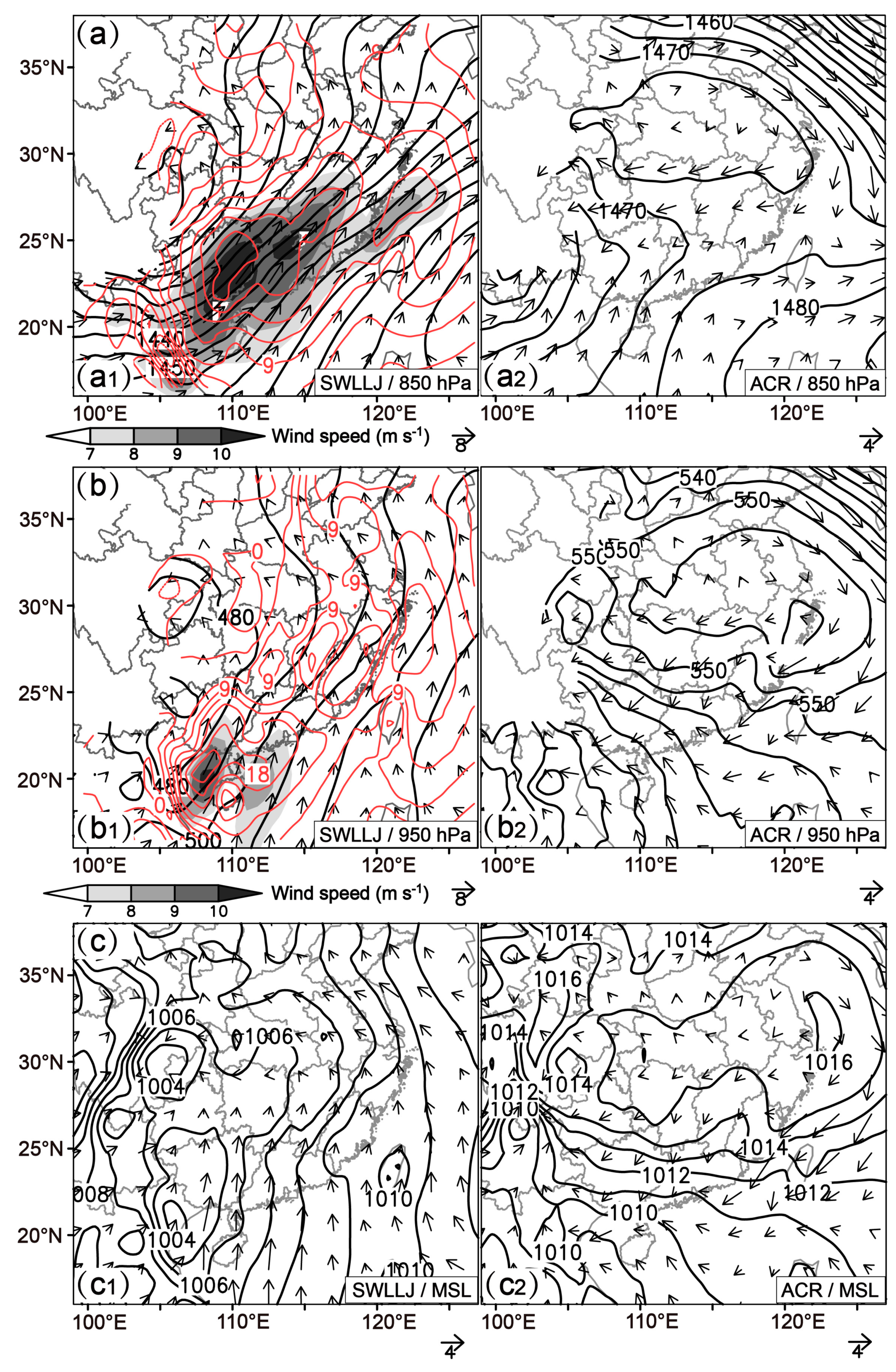
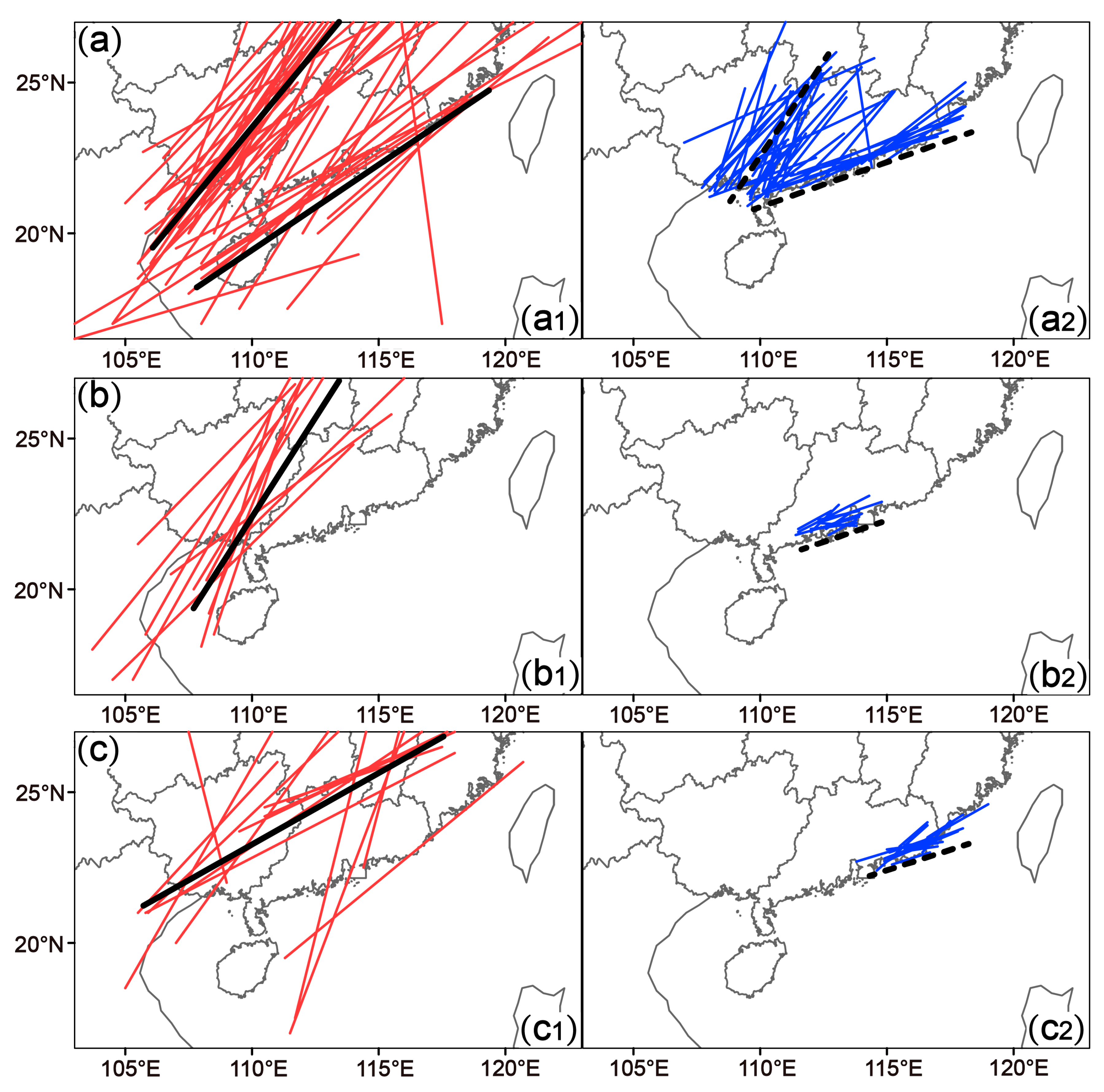
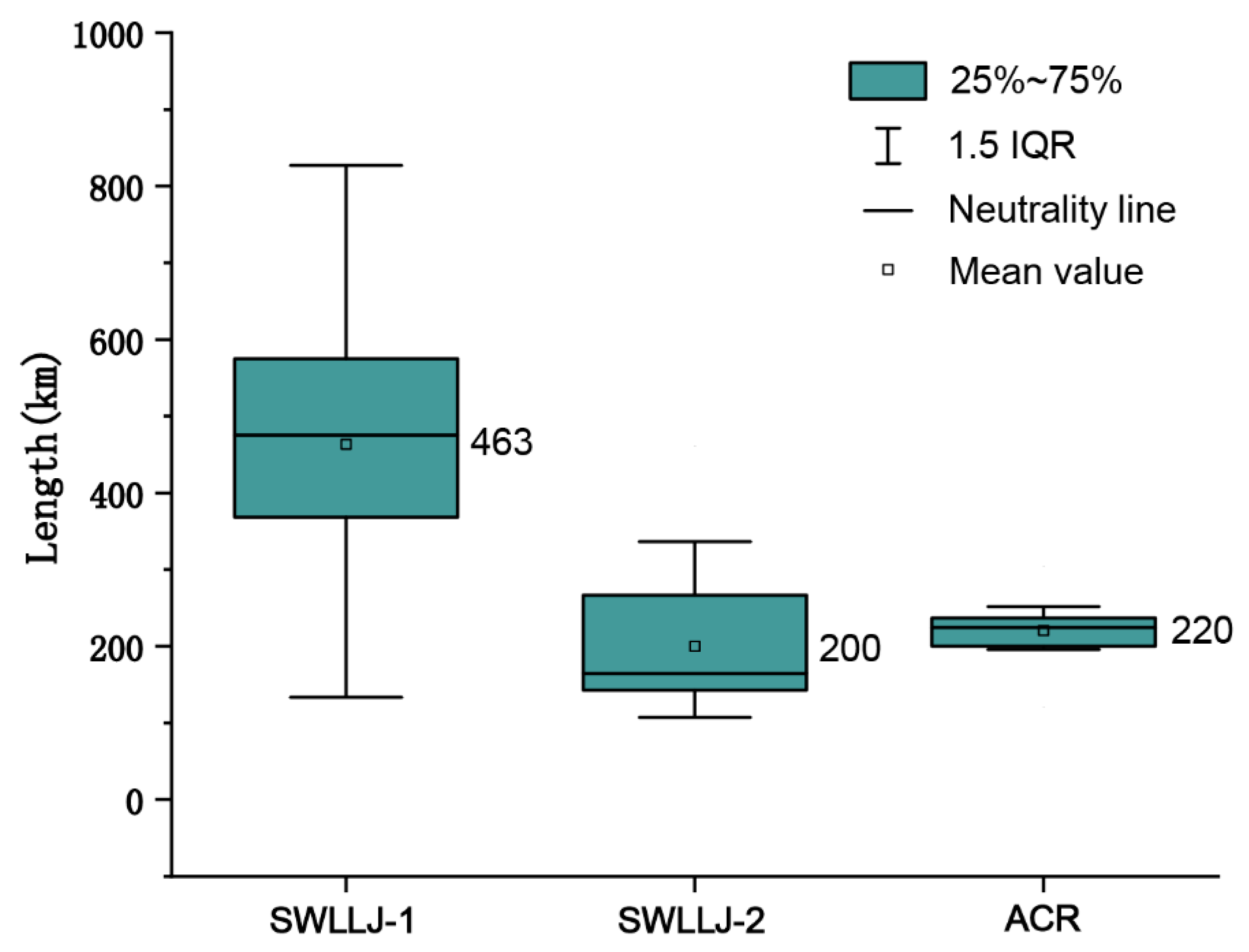
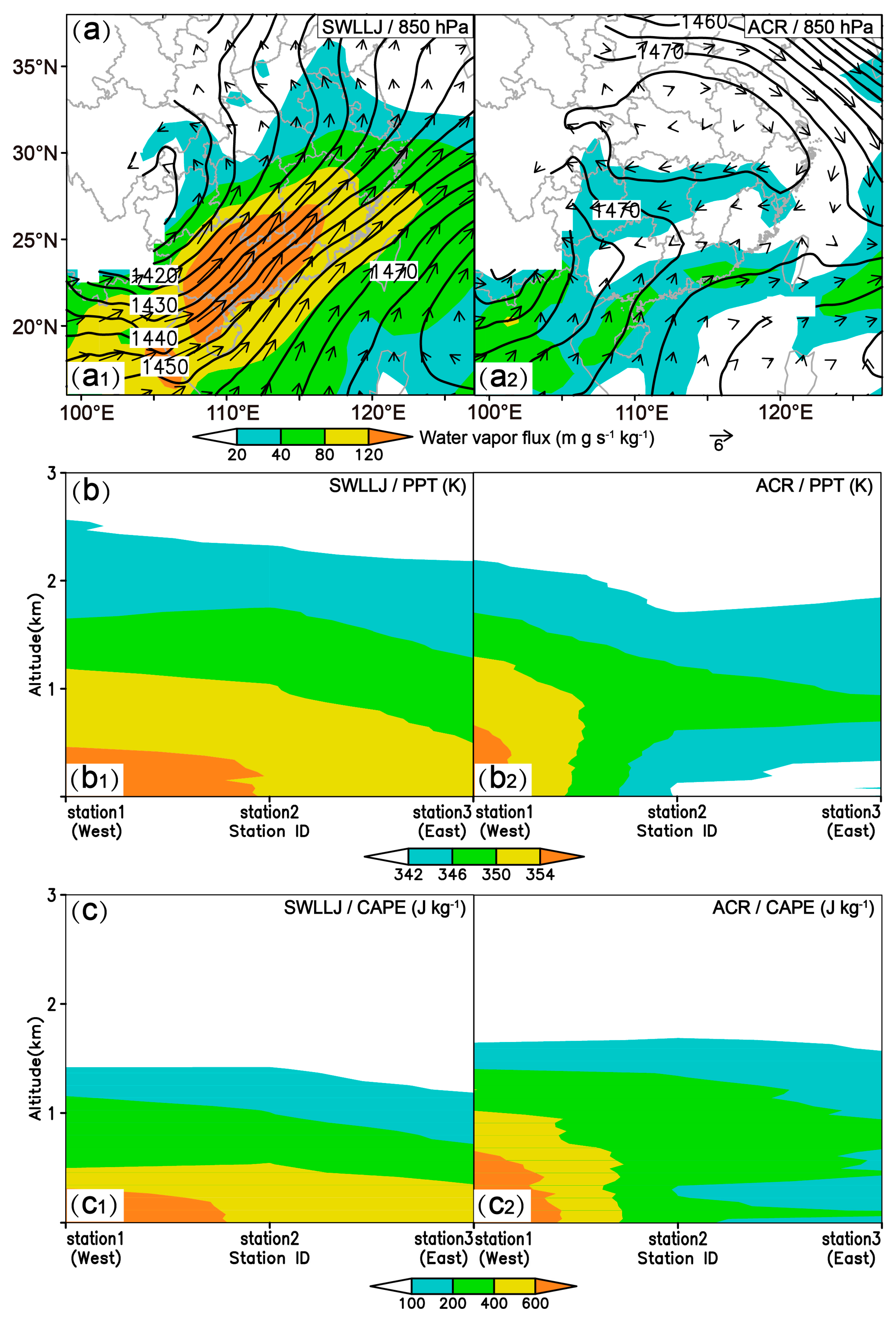

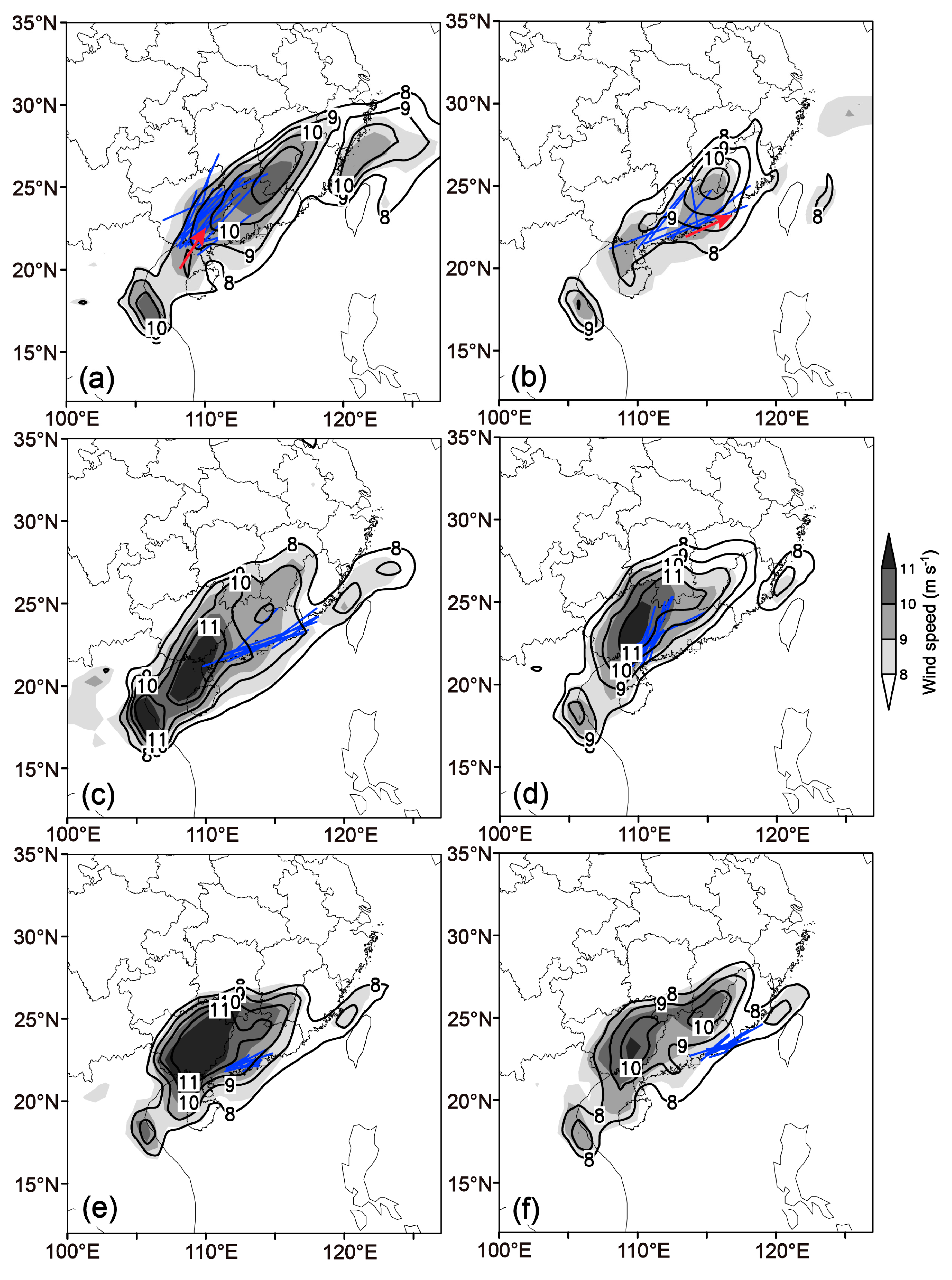
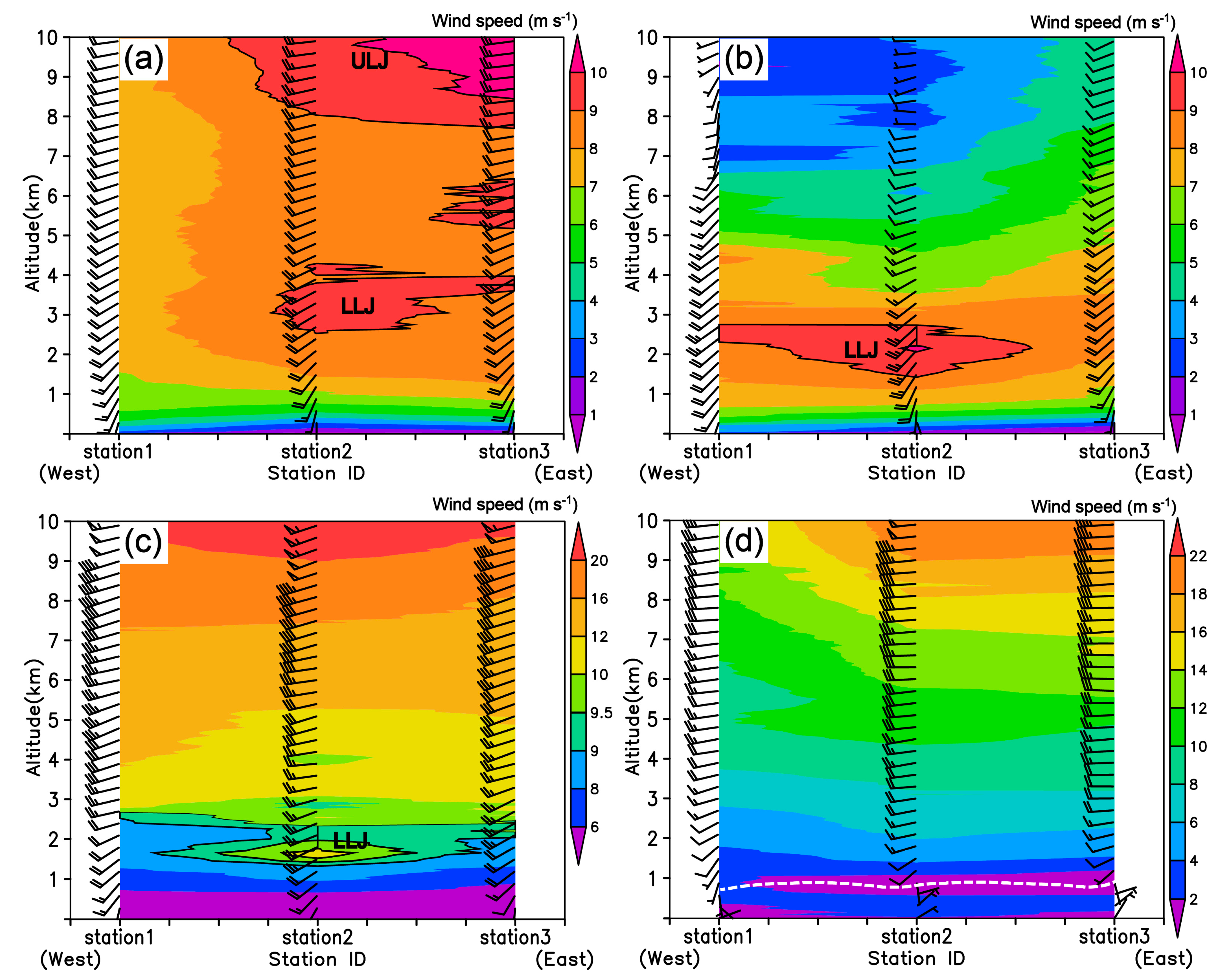
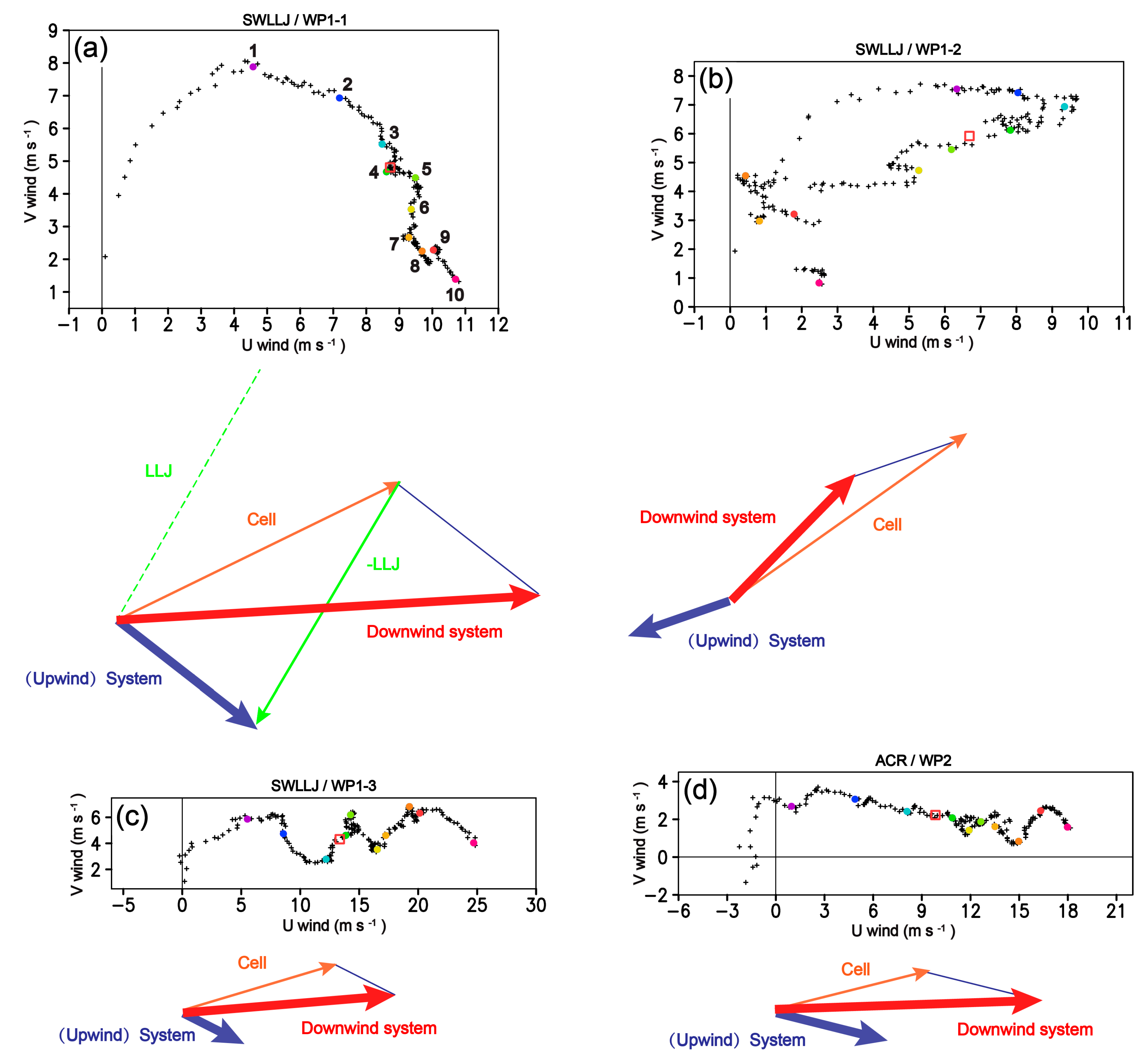
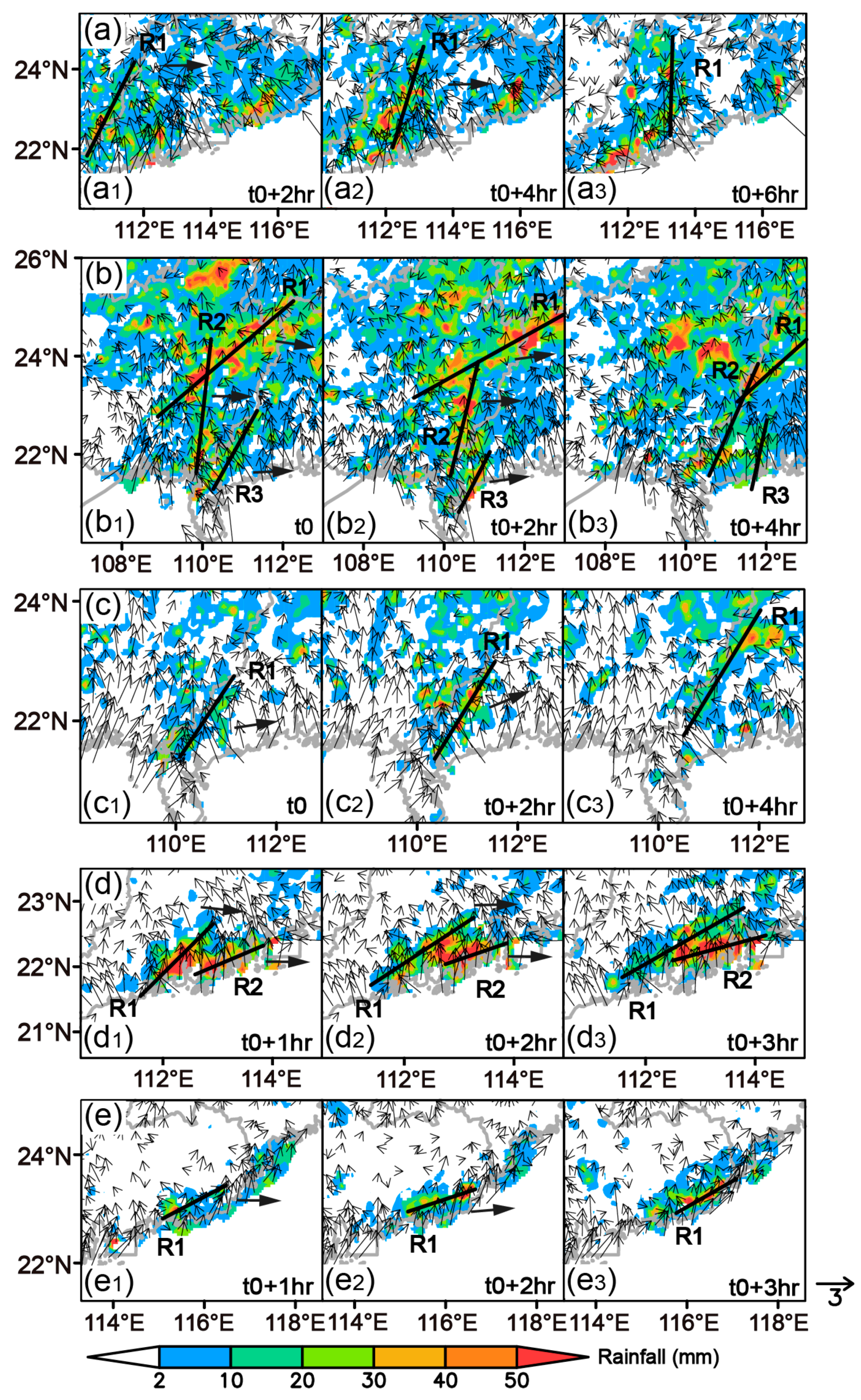
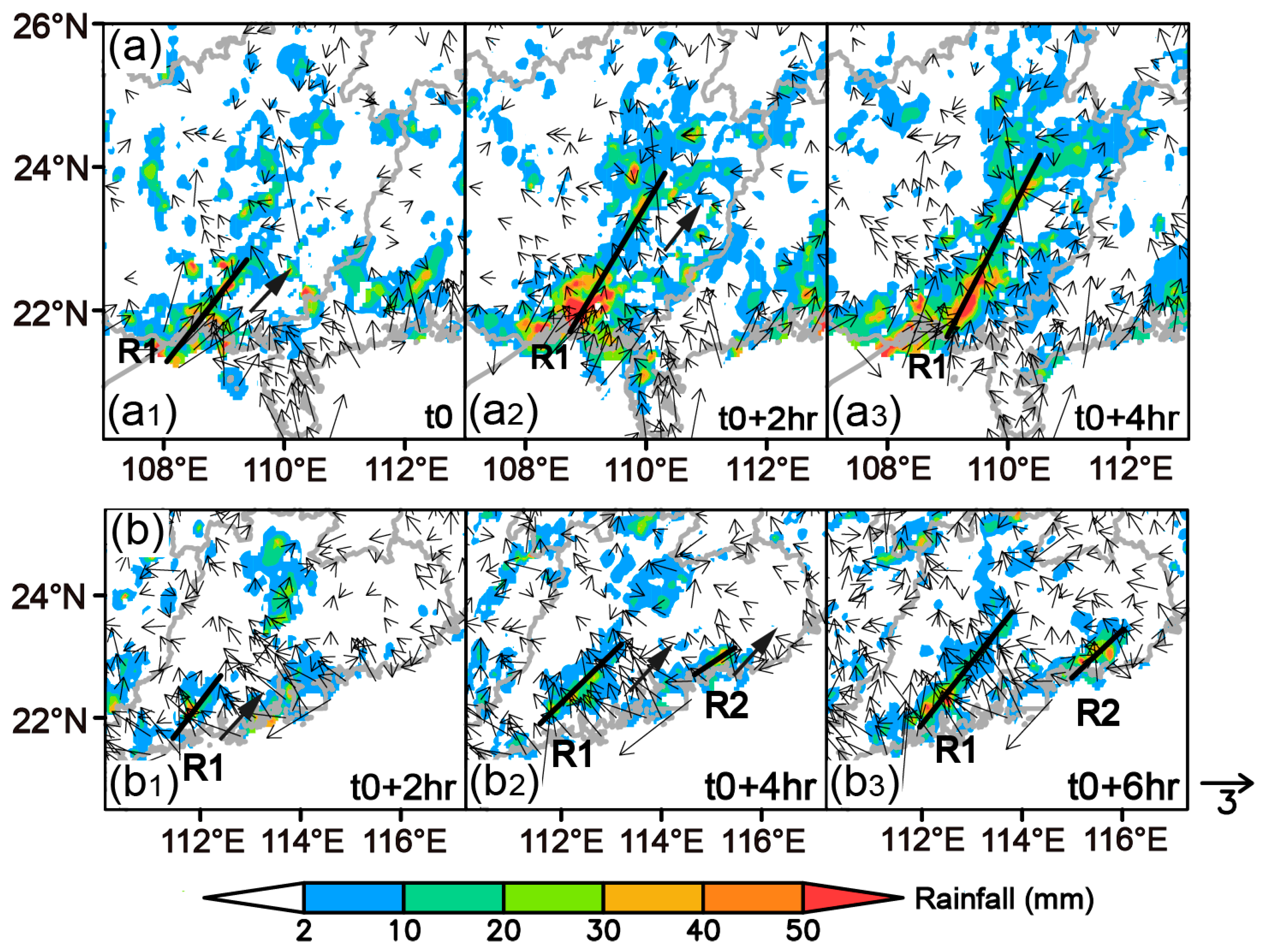
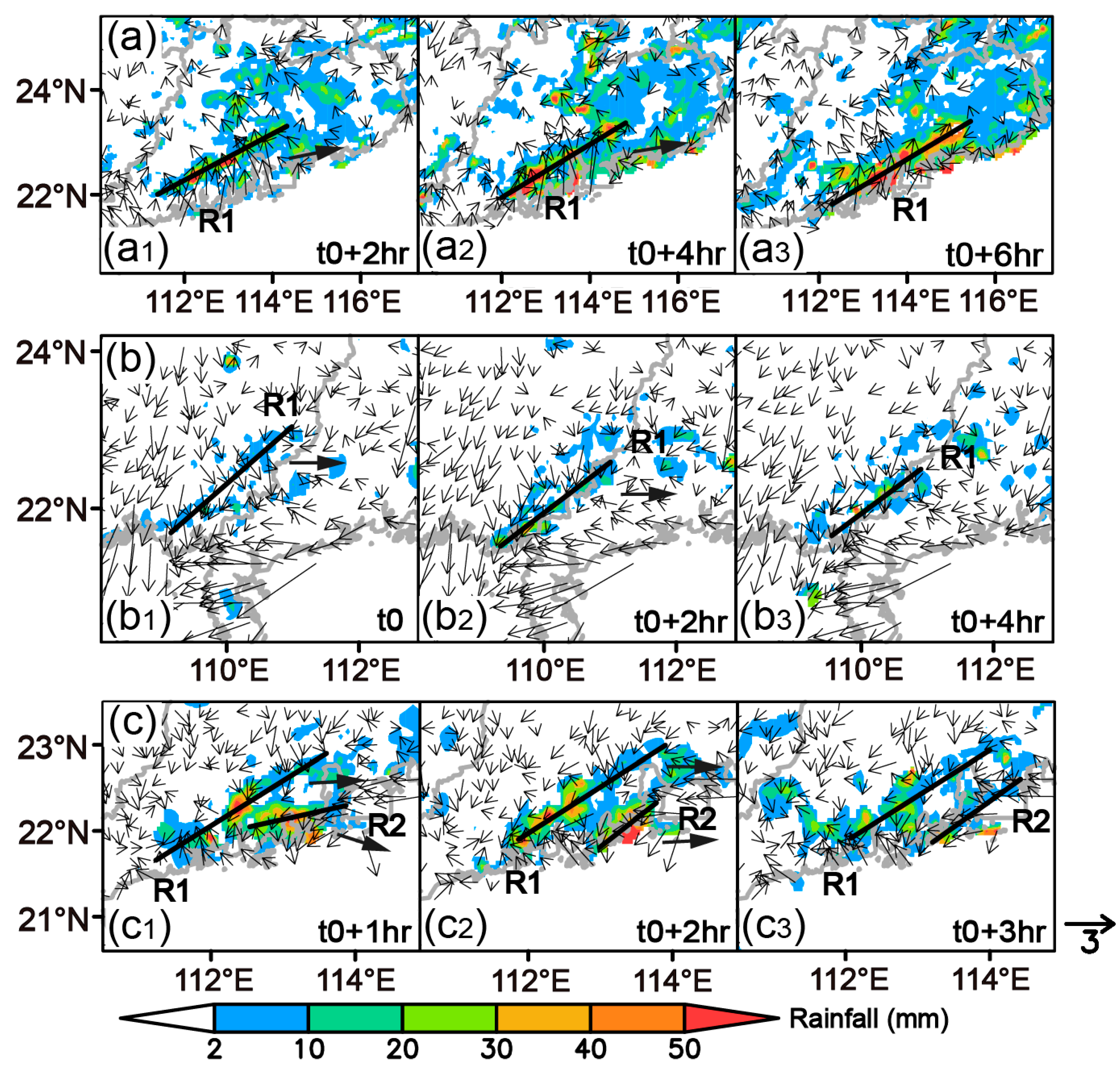
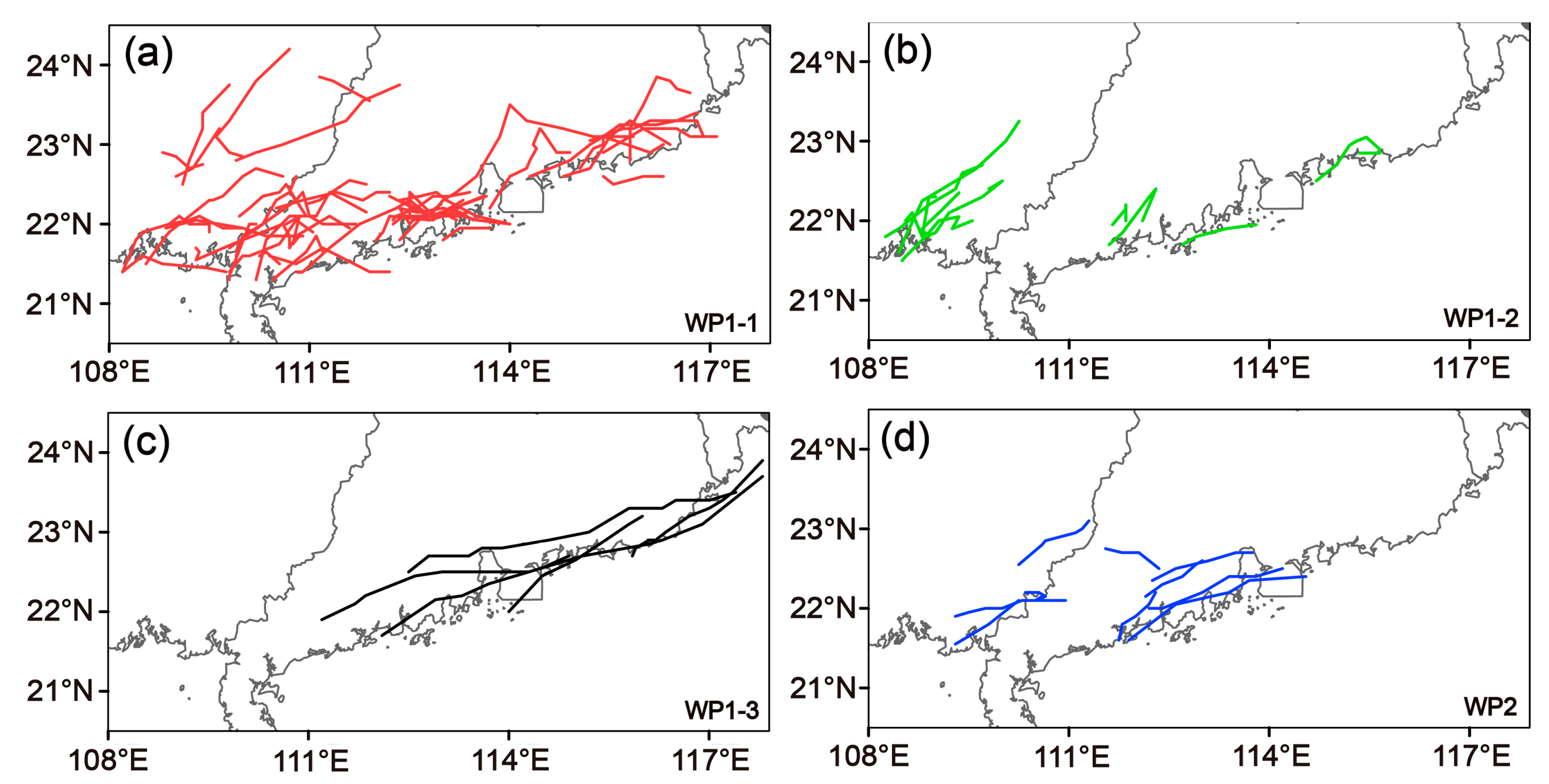
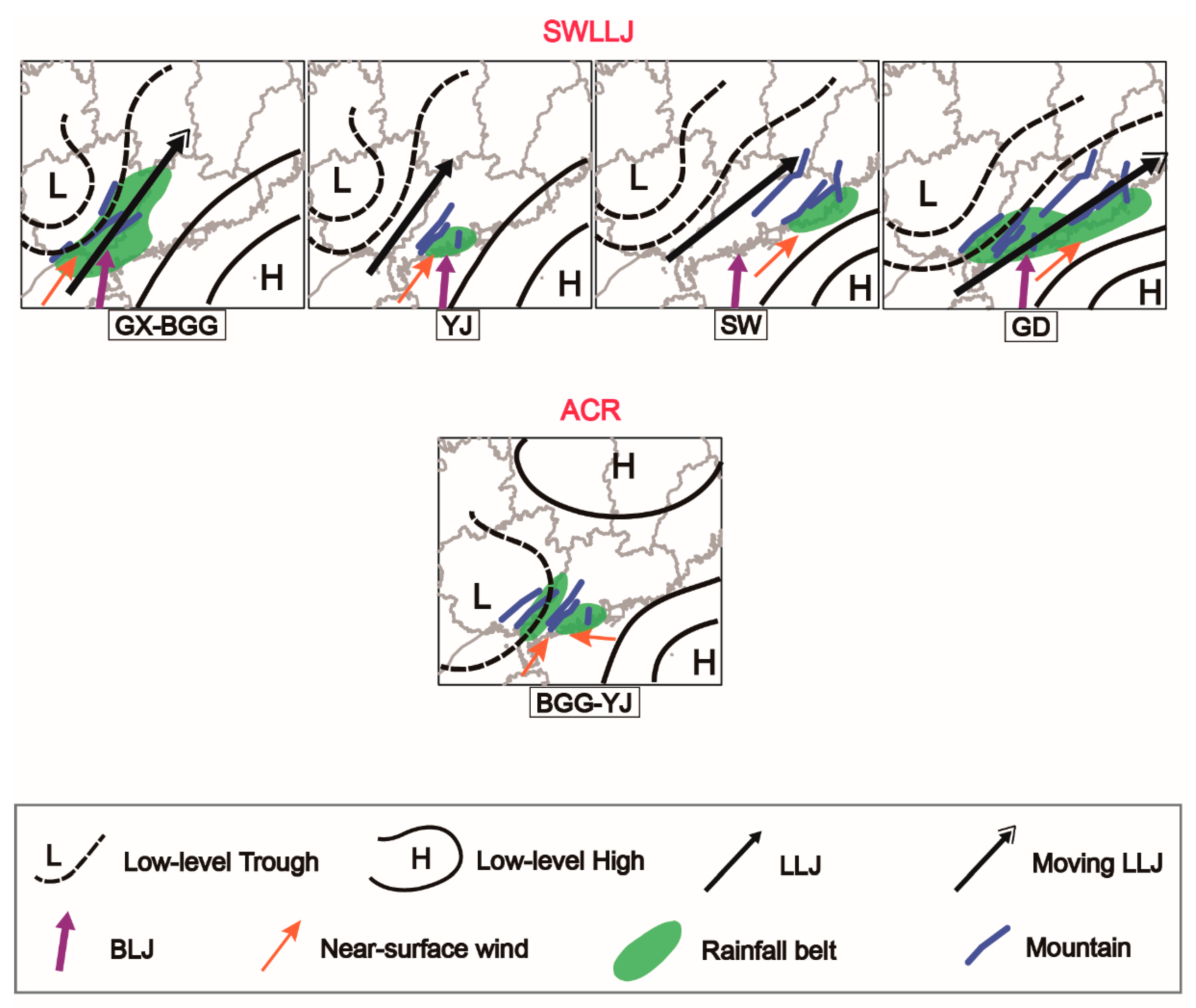
© 2019 by the authors. Licensee MDPI, Basel, Switzerland. This article is an open access article distributed under the terms and conditions of the Creative Commons Attribution (CC BY) license (http://creativecommons.org/licenses/by/4.0/).
Share and Cite
Liang, Z.; Fovell, R.G.; Liu, Y. Observational Analysis of the Characteristics of the Synoptic Situation and Evolution of the Organized Warm-Sector Rainfall in the Coastal Region of South China in the Pre-Summer Rainy Season. Atmosphere 2019, 10, 722. https://doi.org/10.3390/atmos10110722
Liang Z, Fovell RG, Liu Y. Observational Analysis of the Characteristics of the Synoptic Situation and Evolution of the Organized Warm-Sector Rainfall in the Coastal Region of South China in the Pre-Summer Rainy Season. Atmosphere. 2019; 10(11):722. https://doi.org/10.3390/atmos10110722
Chicago/Turabian StyleLiang, Zhaoming, Robert G. Fovell, and Ying Liu. 2019. "Observational Analysis of the Characteristics of the Synoptic Situation and Evolution of the Organized Warm-Sector Rainfall in the Coastal Region of South China in the Pre-Summer Rainy Season" Atmosphere 10, no. 11: 722. https://doi.org/10.3390/atmos10110722
APA StyleLiang, Z., Fovell, R. G., & Liu, Y. (2019). Observational Analysis of the Characteristics of the Synoptic Situation and Evolution of the Organized Warm-Sector Rainfall in the Coastal Region of South China in the Pre-Summer Rainy Season. Atmosphere, 10(11), 722. https://doi.org/10.3390/atmos10110722




